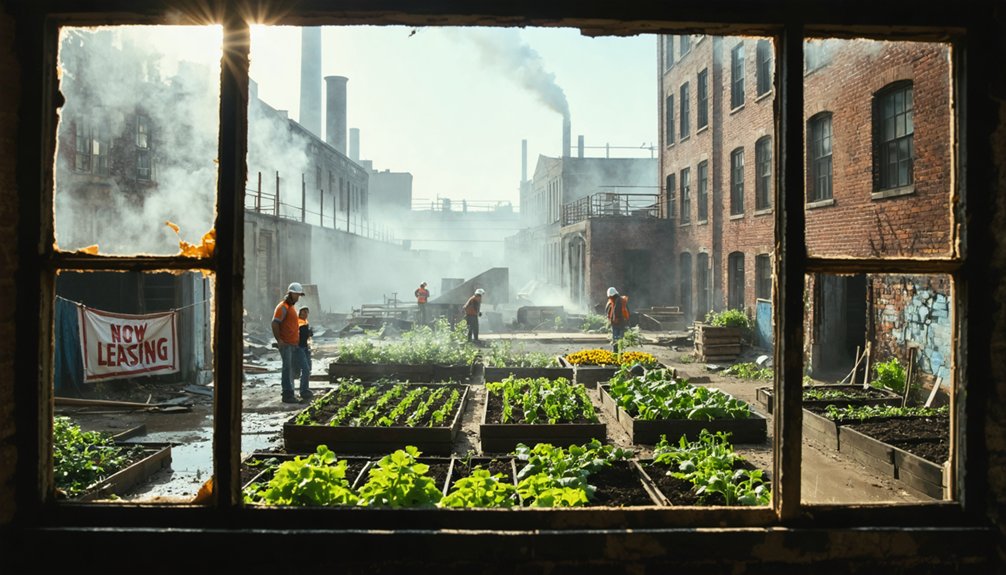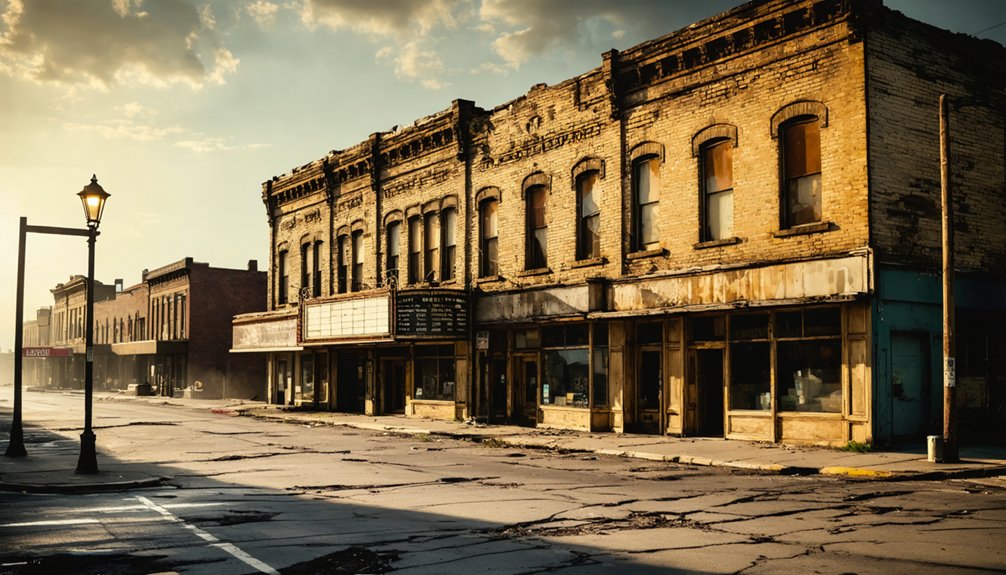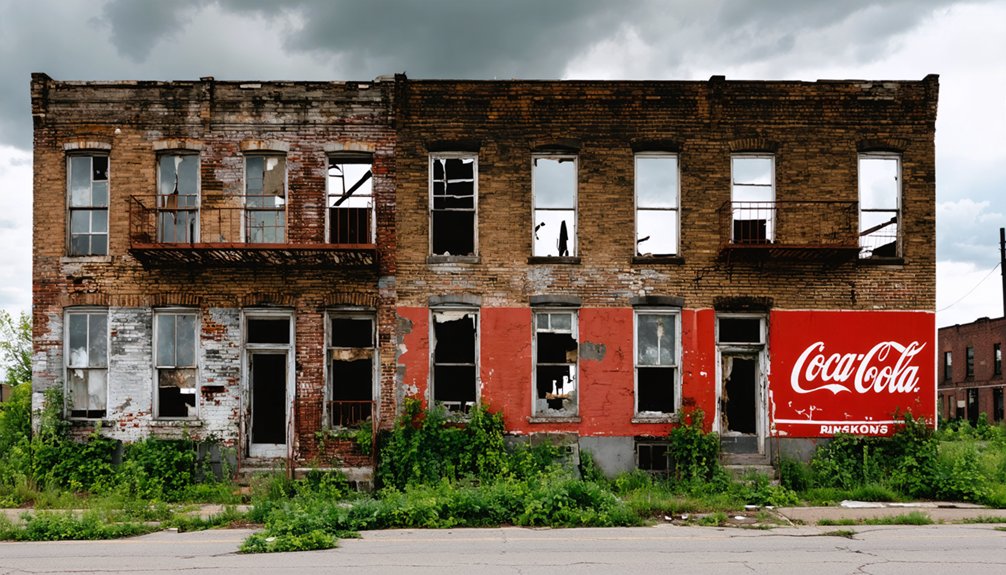To address population decline in Rust Belt ghost towns, you’ll need to focus on five key strategies: revitalize vacant properties through community land trusts, diversify local economies with worker cooperatives and tech incubators, implement resident-led decision making processes, transform industrial heritage into tourism assets, and develop sustainable green infrastructure. These approaches work best when combined into a thorough plan that respects your community’s authentic character while creating pathways to renewed energy. The following approaches offer proven solutions for sustainable revival.
Key Takeaways
- Revitalize vacant properties through community land trusts and adaptive reuse of abandoned buildings to create affordable housing options.
- Diversify local economies by fostering tech startups, healthcare sectors, and worker cooperatives that distribute ownership among employees.
- Implement community-led decision making through resident boards and door-to-door outreach to empower locals in development planning.
- Transform cultural and industrial heritage sites into tourism assets that generate revenue while preserving community identity.
- Develop sustainable infrastructure and green spaces by converting vacant land into urban farms and implementing cost-effective stormwater management.
Revitalizing Vacant Properties Through Affordable Housing Initiatives
As Rust Belt cities grapple with the legacy of population decline, abandoned and vacant properties have emerged as both a challenge and an opportunity for community revitalization.
You’ll find innovative solutions transforming these neglected spaces into valuable affordable housing through federal funding programs like the $6 billion initiative for rehabilitation or demolition of abandoned homes.
Community land trusts offer a promising pathway to neighborhood stability, acquiring vacant properties while ensuring long-term affordability and preventing speculative resale.
Community land trusts transform vacant spaces into affordable homes while safeguarding neighborhoods from speculation.
Cities like Cleveland and Pittsburgh demonstrate how these models effectively maintain community control.
The adaptive reuse of abandoned factories and commercial buildings provides another avenue for expanding housing stock.
Places like Youngstown, Ohio, and Flint, Michigan continue to struggle with high vacancy rates that significantly impact their local economies and housing markets.
Detroit faces similar challenges with nearly 30% of homes empty for two years or longer, indicating persistent abandonment issues.
Through public-private partnerships and strategic policy adjustments—including expedited permitting and tax incentives—you can support transforming vacant properties into vibrant, affordable living spaces.
Fostering Economic Diversification Beyond Traditional Manufacturing
While traditional manufacturing once defined the economic backbone of Rust Belt regions, successful revitalization now demands a multifaceted approach to economic diversification.
You’ll find that establishing worker cooperatives creates local economic resilience by distributing ownership and profits among employees rather than distant shareholders.
Consider how healthcare and technology sectors offer sustainable growth paths—particularly when municipal authorities collaborate with educational institutions to develop targeted training programs.
Reading, Pennsylvania provides an instructive case where leaders are working to create a solidarity economy through cooperative enterprises and public initiatives.
Establishing tech startups through incubators and free rent initiatives allows your community to leverage unique local assets while building innovation capacity.
Regional cooperation expands your market reach while coordinating infrastructure investments.
Strategic migration incentives can attract skilled professionals and entrepreneurs back to these communities, creating a foundation for new economic opportunities.
Building Community-Led Decision Making and Local Engagement
Successful revitalization of struggling Rust Belt communities hinges on authentic resident empowerment through structured community-led decision making processes.
True community empowerment emerges when you establish resident-led boards and governance structures that maintain local control over land and development decisions.
To build effective grassroots collaboration in your community:
- Implement door-to-door outreach and one-on-one conversations to uncover genuine resident concerns and build trust networks.
- Create platforms for dialogue between stakeholders that emphasize collective ownership and unified decision-making.
- Establish community land trusts with 100% local control to prevent displacement during revitalization.
- Balance technical expertise with capacity-building programs that equip residents with knowledge to participate effectively.
This approach guarantees revitalization efforts reflect local values while building the sustainable governance infrastructure needed for long-term community resilience. Organizations like PUSH Buffalo demonstrate how green energy initiatives can create local jobs while addressing environmental concerns in struggling neighborhoods. Maintaining clear communication with residents throughout development processes ensures transparency and builds trust in community-led efforts.
Leveraging Cultural Heritage as an Economic Development Tool
Transforming cultural and industrial heritage into economic assets represents one of the most powerful yet underutilized strategies for Rust Belt revitalization.
You can generate significant tourism revenue by adapting abandoned industrial sites into immersive heritage experiences that showcase your community’s authentic story.
The economics are compelling: heritage preservation creates diverse employment opportunities through museum operations, guided tours, and hospitality services while reducing infrastructure costs.
Repurposing heritage sites creates jobs and economic value while lowering the burden on municipal budgets.
When you convert former factories and warehouses into cultural tourism destinations, you’re not just preserving buildings—you’re maintaining collective memory and cultural identity.
The most successful projects integrate community narratives directly from local residents and retired workers.
These firsthand accounts transform symbols of decline into sources of pride while providing visitors the authentic experiences they’ll pay premium tourism dollars to experience.
Cities like Pittsburgh have successfully pivoted from industrial wastelands to cultural destinations through strategic investment in abandoned infrastructure repurposing.
Neighborhoods like McDougall-Hunt in Detroit demonstrate how art installations like the Heidelberg Project can attract hundreds of thousands of visitors annually despite experiencing severe housing abandonment.
Creating Sustainable Infrastructure and Green Development Projects
As Rust Belt cities confront the dual challenges of aging infrastructure and population loss, implementing green development projects offers a practical pathway to sustainable revival.
You’ll find that green infrastructure solutions address multiple problems simultaneously while costing a fraction of traditional approaches.
Detroit’s transformation of 20 square miles into urban farms demonstrates how vacant land becomes an asset rather than liability.
Consider these proven strategies:
- Install infiltration beds and create small depressions on demolished sites to manage stormwater naturally
- Convert vacant lots into community gardens that serve as neighborhood anchors
- Deploy solar panels on unused properties to generate clean energy and maintain tax revenue
- Repurpose historic structures rather than demolishing them
These approaches leverage your community’s existing assets while creating more resilient, environmentally sound infrastructure for future generations. Concentrating redevelopment in strategic nodes and corridors allows cities to focus limited resources while maintaining green spaces between developed areas. Cities like Pittsburgh have successfully positioned themselves as tech hubs for biotech and nanotech by utilizing their low property values and existing infrastructure.
Frequently Asked Questions
How Long Does a Typical Rust Belt Revitalization Project Take?
You’ll find revitalization timelines typically span 5-15 years, with smaller projects completed in 3-7 years and larger transformations requiring 10+ years across multiple project phases, depending on funding and complexity.
What Psychological Impacts Does Population Decline Have on Remaining Residents?
You’ll feel isolation’s grip tightening as neighbors vanish. Your community identity fractures, triggering loneliness, depression, and anxiety. Mental health suffers while stress escalates, especially without adequate support systems nearby.
How Do School Systems Adapt to Dramatically Shrinking Student Populations?
You’ll see schools consolidate facilities, reduce staff through attrition, and make curriculum adjustments focusing on essential skills. They’ll form community partnerships while reconfiguring grade levels to maximize limited resources and maintain educational quality.
What Legal Challenges Exist When Acquiring Abandoned Properties With Unclear Ownership?
You’ll face title cloudiness, property rights disputes, and ownership verification problems when acquiring abandoned buildings. Tax foreclosures, adverse possession requirements, and municipal liens often create multilayered legal entanglements requiring specialized resolution.
How Do Revitalized Communities Prevent Gentrification and Displacement of Original Residents?
Imagine a community where everyone belongs! You’ll prevent displacement by implementing community land trusts, enforcing strong inclusionary zoning requirements, promoting community engagement, and establishing inclusive policies that prioritize long-term residents’ autonomy in development decisions.
References
- https://www.clevelandfed.org/publications/economic-commentary/2013/ec-201306-urban-decline-in-rust-belt-cities
- https://www.youtube.com/watch?v=HZFw7MZFycU
- https://en.wikipedia.org/wiki/Population_decline
- https://schoolofcities.utoronto.ca/neighbourhood-abandonment-in-the-american-rust-belt/
- https://files.eric.ed.gov/fulltext/ED458055.pdf
- https://www.cato.org/blog/economic-mobility-not-manufacturing-decline-real-rust-belt-story
- https://www.aeaweb.org/research/rethinking-detroit-vacant-development-guarantees
- https://fiveable.me/key-terms/united-states-history-since-1945/rust-belt-decline
- https://247wallst.com/special-report/2018/11/02/30-american-ghost-towns-3/
- https://www.877gethope.org/generated/uploads/Strategies_HUD_Study_Set.docx.pdf



